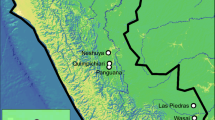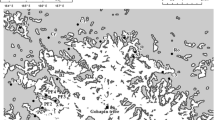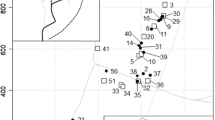Abstract
Slave-making ants exploit the societies of host ant species and are typically rare and patchily distributed. IUCN considers almost all slave-making ants as vulnerable, but solid data on their actual abundance are uncommon. Here we examine the genetic structure of populations of two species of the socially parasitic genus Myrmoxenus, which differ strongly in dispersal behavior and the occurrence of slave-raids. Microsatellite genotypes suggest strong differentiation even among neighboring populations of both species. FST-, G″ST-, and D-values were considerably higher in the “degenerate slave-maker” M. kraussei from Northern Italy than in the active slavemaker M. ravouxi from Southern Germany. This matches observations that sexuals of M. kraussei mate in their natal nest and queens disperse on foot while sexuals of M. ravouxi engage in mating and dispersal flights. Allelic richness was surprisingly high in both species and did not suggest recent bottlenecks, indicating that populations are larger and less vulnerable than expected from the difficulties of locating nests. Despite of considerable inbreeding, only very few diploid males were detected, supporting the view that at least in M. kraussei sex is not determined by single locus complementary sex determination unlike most other social Hymenoptera. The mismatch between the genetic and social structure of M. ravouxi colonies indicates occasionally fusion of slave-maker colonies in the field, mutual raids, or queen replacement. Complementary analyses of the host species of the two social parasites, Temnothorax unifasciatus and T. recedens, revealed low levels of population differentiation and confirmed the colony structure with a single, singly-mated queen.
Similar content being viewed by others
References
Beibl J, Stuart RJ, Heinze J, Foitzik S (2005) Six origins of slavery in formicoxenine ants. Insect Soc 52:291–297
Blatrix R, Sermage C (2005) Role of early experience in ant enslavement: a comparative analysis of a host and a non-host species. Front Zool 2:13
Bourke AFG (1988) Dominance orders, worker reproduction, and queen-worker conflict in the slave-making ant Harpagoxenus sublaevis. Behav Ecol Sociobiol 23:323–333
Brandt M, Foitzik S, Fischer-Blass B, Heinze J (2005) The coevolutionary dynamics of obligate ant social parasite systems—between prudence and antagonism. Biol Rev 80:251–267
Brandt M, Fischer-Blass B, Heinze J, Foitzik S (2007) Population structure and the co-evolution between social parasites and their hosts. Mol Ecol 16:2063–2078
Brunner E, Trindl A, Falk KH, Heinze J, d’Ettorre P (2005) Reproductive conflict in social insects: male production by workers in a slave-making ant. Evolution 59:2480–2482
Buschinger A (1974) Experimente und Beobachtungen zur Gründung und Entwicklung neuer Sozietäten der sklavenhaltenden Ameise Harpagoxenus sublaevis (Nyl.). Insect Soc 21:381–406
Buschinger A (1986) Evolution of social parasitism in ant. Trends Ecol Evol 1:155–160
Buschinger A (1989) Evolution, speciation, and inbreeding in the parasitic ant genus Epimyrma (Hymenoptera, Formicidae). J Evol Biol 2:265–283
Buschinger A (1991) Host specificity and host selection in parasitic ants. In: Proceedings of the 4th ECE/XIII. SIEEC, Gödöllö, pp 682–685
Buschinger A, Winter U (1983) Population studies of the dulotic ant, Epimyrma ravouxi, and the degenerate slavemaker, E. kraussei (Hymenoptera: Formicidae). Entomol Gener 8:251–266
Buschinger A, Fischer K, Guthy H-P, Jessen K, Winter U (1986) Biosystematic revision of Epimyrma kraussei, E. vandeli, and E. foreli (Hymenoptera: Formicidae). Psyche 93:253–276
Chapuis M-P, Estoup A (2007) Microsatellite null alleles and estimation of population differentiation. Mol Biol Evol 24:621–631
D’Ettorre P, Heinze J (2001) Sociobiology of slave-making ants. Acta Ethol 3:67–82
Darwin C (1859) On the origin of species by means of natural selection. John Murray, London
Delattre O, Blatrix R, Châline N, Chameron S, Fédou A, Leroy C, Jaisson J (2012) Do host species evolve a specific response to slave-making ants? Front Zool 9:38
Delattre O, Châline N, Chameron S, Lecoutey E, Jaisson P (2013) Opportunist slave-making ants Myrmoxenus ravouxi discriminate different host species from a non-host species. Insectes Soc 60:7–13
Foitzik S, Heinze J (1998) Nest site limitation and colony takeover in the ant Leptothorax nylanderi. Behav Ecol 9:367–375
Foitzik S, Heinze J (2001) Microgeographic genetic structure and intraspecific parasitism in the ant Leptothorax nylanderi. Ecol Entomol 26:449–456
Foitzik S, Herbers JM (2001) Colony structure of a slavemaking ant. 1. Intracolony relatedness, worker reproduction, and polydomy. Evolution 55:307–315
Franks NR, Scovell E (1983) Dominance and reproductive success among slave-making worker ants. Nature 304:724–725
Gerlach G, Jueterbock A, Kraemer P, Deppermann J, Harmand P (2010) Calculations of population differentiation based on GST and D: forget GST but not all of statistics! Mol Ecol 19:3845–3852
Hammond RL, Keller L (2004) Conflict over male parentage in social insects. PLoS Biol 2:e248
Hein S, Poethke H-J, Dorn S (2009) What stops the ‘diploid male vortex’?—a simulation study for species with single locus complementary sex determination. Ecol Model 220:1663–1669
Heinze J (1996a) The reproductive potential of workers in slave-making ants. Insectes Soc 43:319–328
Heinze J (1996b) Reproductive hierarchies among workers of the slave-making ant, Chalepoxenus muellerianus. Ethology 102:117–127
Heinze J, Ortius D (1991) Social organization of Leptothorax acervorum from Alaska (Hymenoptera: Formicidae). Psyche 98:227–240
Heinze J, Puchinger W, Hölldobler B (1997) Worker reproduction and social hierarchies in Leptothorax ants. Anim Behav 54:849–864
Hölldobler B, Wilson EO (1990) The ants. Harvard University Press, Cambridge
Jessen K, Buschinger A (1994) Specificity of chemical communication during slave raids in dulotic ants, the genera Epimyrma Emery and Myrmoxenus Ruzsky (Hymenoptera, Formicidae). Memorab Zool 48:109–114
Johnstone RA, Hurst GXDD (1996) Maternally inherited male-killing microorganisms may confound interpretation of mitochondrial DNA variability. Biol J Linn Soc 58:453–470
Jost L (2008) GST and its relatives do not measure differentiation. Mol Ecol 17:4015–4026
Jueterbock A, Kraemer P, Gerlach G, Deppermann J (2010) DEMEtics: evaluating the genetic differentiation between populations based on GST and D values. R package version 0.8-2
Kalinowski ST (2004) Counting alleles with rarefaction: private alleles and hierarchical sampling designs. Conserv Genet 5:539–543
Kalinowski ST (2005) HP-Rare: a computer program for performing rarefaction on measures of allelic diversity. Mol Ecol Notes 5:187–189
Kellner K, Barth B, Heinze J (2010) Colony fusion causes within-colony variation in a parthenogenetic ant. Behav Ecol Sociobiol 64:737–746
Luikart G, Allendorf FW, Cornuet J-M, Sherwin WB (1998) Distortion of allele frequency distributions provides a test for recent population bottlenecks. J Hered 89:238–247
Lynch M, Ritland K (1999) Estimation of pairwise relatedness with molecular markers. Genetics 152:1753–1766
Martz H (2007) Die Sklaven haltende Ameise Myrmoxenus ravouxi an Hochrhein und Bodensee. Ameisenschutz aktuell 21:76–78
Matsuura K, Nishida T (2001) Colony fusion in a termite: what makes the society “open”? Insectes Soc 48:378–383
Pamilo P, Crozier RH (1997) Population biology of social insect conservation. Mem Mus Vict 56:411–419
Peakall R, Smouse PE (2012) GenAlEx 6.5: genetic analysis in Excel. Population genetic software for teaching and research-an update. Bioinformatics 28:2537–2539
Plateaux L (1978) L’essaimage de quelques fourmis Leptothorax: rôles de l’éclairement et de divers autres facteurs. Effet sur l’isolement reproductif et la répartition géographique. 1re partie. Ann Sci Nat Zool Biol Anim 12:129–164
Queller DC, Goodnight KF (1989) Estimating relatedness using genetic markers. Evolution 43:258–275
Raymond M, Rousset F (1995) GenePop (version 1.2): population genetics software for exact tests and ecumenicism. J Hered 86:248–249
Rousset F (2008) GENEPOP ‘007: a complete reimplementation of the GENEPOP software for Windows and Linux. Mol Ecol Resour 8:103–106
Russell JA, Funaro CF, Giraldo YM, Goldman-Huertas B, Suh D, Kronauer DJC, Moreau CS, Pierce NE (2012) A veritable menagerie of heritable bacteria from ants, butterflies, and beyond: broad molecular surveys and a systematic review. PLoS ONE 7:e51027
Sambrook J, Russell D (2001) Molecular Cloning, 3rd edn. Cold Spring Harbor Laboratory Press, New York
Sanllorente O, Hammond RL, Ruano F, Keller L, Tinaut A (2010) Extreme population differentiation in a vulnerable slavemaking ant with fragmented distribution. Conserv Genet 11:1701–1710
Schulz A, Sanetra M (2002) Notes on the socially parasitic ants of Turkey and the synonymy of Epimyrma (Hymenoptera, Formicidae). Entomofauna 23:157–172
Schwacke L, Schwacke J, Rosel P (2005) RERAT: relatedness estimation and rarefaction analysis tool. http://people.musc.edu/~schwaclh/
Seifert B (2007) Die Ameisen Mittel- und Nordeuropas. Lutra, Tauer
Seppä P (2008) Do ants (Hymenoptera: Formicidae) need conservation and does ant conservation need genetics? Myrmecol News 11:161–172
Shoemaker DD, Keller G, Ross KG (2003) Effects of Wolbachia on mtDNA variation in two fire ant species. Mol Ecol 12:1757–1771
Suefuji M, Trindl A, Heinze J (2011) Characterization of 13 microsatellite markers for the threatened, slave-making ant Myrmoxenus ravouxi (Formicidae: Myrmicinae). Conserv Genet Resour 3:229–331
Trivers RL, Hare H (1976) Haplodiploidy and the evolution of the social insects. Science 191:249–263
Trontti K, Aron S, Sundström L (2006) The genetic population structure of the ant Plagiolepis xene—implications or genetic vulnerability of obligate social parasites. Conserv Genet 7:241–250
Wenseleers T (1998) Conflict from cell to colony. Ph.D. Thesis, University of Leuven, Leuven
Winter U, Buschinger A (1983) The reproductive biology of a slavemaker Ant, Epimyrma ravouxi, and a degenerate slavemaker, E. kraussei (Hymenoptera: Formicidae). Entomol Gener 9:1–15
Yasuno M (1964) The study of the ant population in the grassland at Mt. Hakkoda. III. The effect of the slave-making ant, Polyergus samurai, upon the nest distribution pattern of the slave ant, Formica fusca japonica. Sci Rep Tohoku Univ Fourth Ser Biol 30:167–170
Zayed A (2004) Effective population size in Hymenoptera with complementary sex determination. Heredity 93:627–630
Zayed A, Packer L (2005) Complementary sex determination substantially increases extinction proneness of haplodiploid populations. Proc Natl Acad Sci USA 102:10742–10746
Acknowledgments
The study was supported by Deutsche Forschungsgemeinschaft (He1623/26). We thank B. Lautenschläger, N. Gratiashvili, H. Martz, and C. Wanke for their help in the field and P. Sturm, Akademie für Naturschutz und Landschaftspflege, for advice concerning the conservation status of Myrmoxenus ravouxi in Bavaria.
Author information
Authors and Affiliations
Corresponding author
Electronic supplementary material
Below is the link to the electronic supplementary material.
10592_2013_531_MOESM1_ESM.docx
Supplementary Table 1 Primer sequences, repeat motif, and annealing temperature (Ta) of microsatellite loci used inthis study and not previously described by Suefuji et al. (2011) (DOCX 24 kb)
Rights and permissions
About this article
Cite this article
Suefuji, M., Heinze, J. The genetic population structure of two socially parasitic ants: “the active slave-maker” Myrmoxenus ravouxi and the “degenerate slave-maker” M. kraussei . Conserv Genet 15, 201–211 (2014). https://doi.org/10.1007/s10592-013-0531-6
Received:
Accepted:
Published:
Issue Date:
DOI: https://doi.org/10.1007/s10592-013-0531-6




